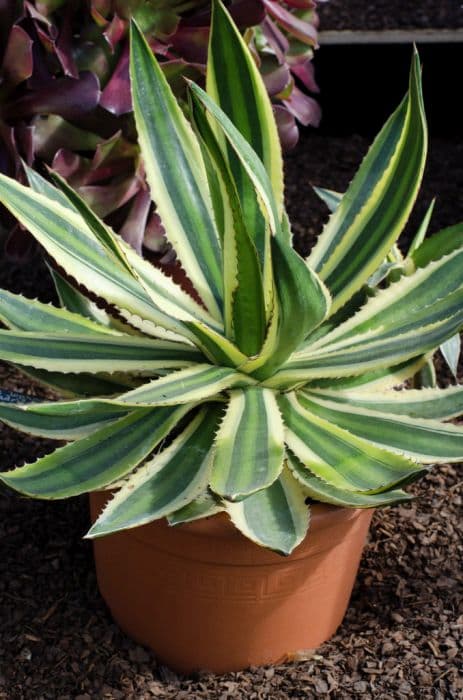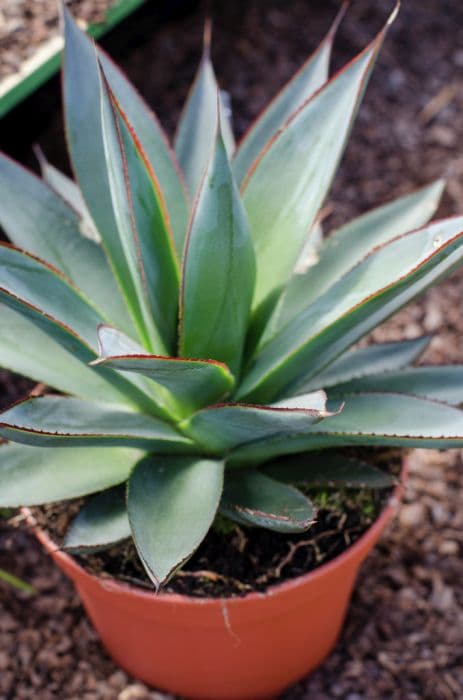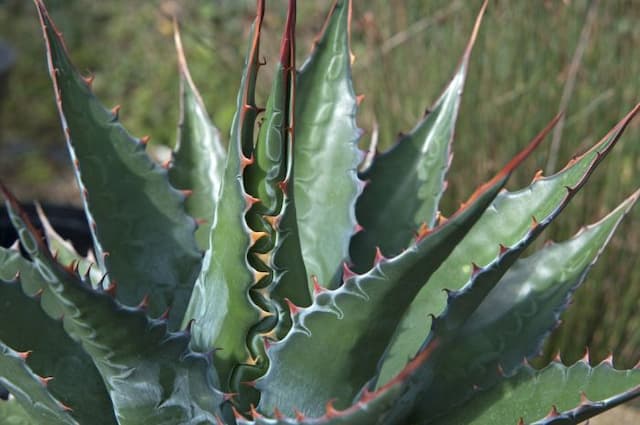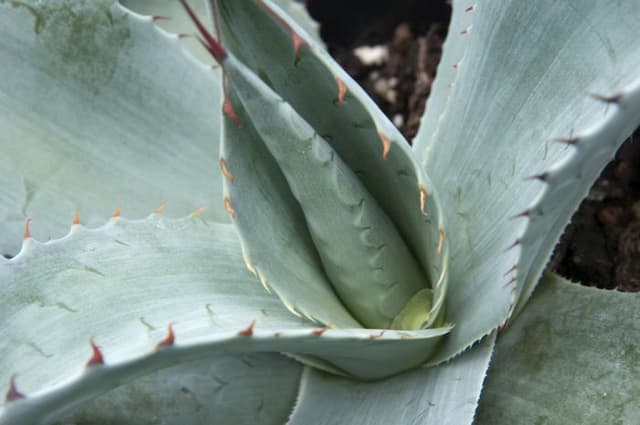Quadricolor Century Plant Agave univittata 'Quadricolor' (v)

ABOUT
The 'Quadricolor' variety of the century plant is a visually striking plant known for its vibrant foliage. The leaves display a distinctive arrangement of colors in four distinct bands running the length of each leaf. The central part of the leaf typically presents a bright green color, surrounded by a rich yellow stripe which is edged on both sides with a creamy-white zone, adding a striking contrast. The outermost band is characteristically a dark green, bordering the white band and providing a bold outline to the creamy stripes. As an added touch, the leaves showcase marginal spines that curve backwards and can range in coloration, sometimes appearing dark or pale depending on the individual plant. The tips of the leaves culminate in a sharp brown or black spine that accentuates the linear form of each leaf. This variegation and coloration pattern give the plant a dramatic and ornamental appearance, making it a favored choice for gardeners and collectors seeking to add a touch of exotic flair to their landscapes or indoor plant collections.
About this plant
 Names
NamesFamily
Asparagaceae
Synonyms
Quadricolor Century Plant, Variegated Agave, Four Color Agave
Common names
Agave univittata var. quadricolor, Agave lophantha 'Quadricolor'.
 Toxicity
ToxicityTo humans
The Center Stripe Agave is generally not considered toxic to humans if ingested in small quantities, but the sap from the plant could potentially cause skin irritation or allergic reactions in some individuals. Some agave species can cause minor stomach irritation if ingested, but there are no widespread reports of serious poisoning from Agave univittata 'Quadricolor'. However, as a precaution, it is advised to avoid ingesting the plant and to handle it with care to prevent skin irritation.
To pets
The Center Stripe Agave may present similar risks to pets as it does to humans. While it may not be highly toxic if ingested, the sap can cause skin irritation, and if ingested in larger quantities, it could potentially cause stomach upset or irritation to dogs or cats. It is always best to keep pets away from this plant to avoid any potential risks, as different animals may react differently to plant saps and other compounds. If you suspect your pet has ingested part of the agave, monitor for signs of discomfort or allergic reactions and seek veterinary care if symptoms arise.
 Characteristics
CharacteristicsLife cycle
Perennials
Foliage type
Evergreen
Color of leaves
Mixed
Height
2 feet (60 cm)
Spread
2 feet (60 cm)
Plant type
Succulent
Hardiness zones
9
Native area
Mexico
Benefits
 General Benefits
General Benefits- Decorative Appeal: Features striking multicolored leaves that enhance aesthetic value of gardens and indoor spaces.
- Drought Tolerance: Highly resistant to drought, requiring minimal water which is beneficial in arid climates or water-scarce areas.
- Low Maintenance: Requires little care beyond occasional watering and is resilient to neglect, making it ideal for busy or novice gardeners.
- Pest Resistance: Naturally resistant to many pests, reducing the need for chemical pesticides.
- Adaptability: Able to thrive in a range of environments, from full sun to partial shade.
- Soil Versatility: Grows well in a variety of soil types, as long as there is good drainage.
- Long Lifespan: Being a perennial, it can live for many years and does not require frequent replanting.
- Architectural Structure: Adds structural interest to landscape designs due to its form and texture.
 Medical Properties
Medical PropertiesThis plant is not used for medical purposes.
 Air-purifying Qualities
Air-purifying QualitiesThis plant is not specifically known for air purifying qualities.
 Other Uses
Other Uses- Agave univittata 'Quadricolor' can be used as a barrier plant due to its spiky foliage, which can deter animals and unwanted foot traffic through garden areas.
- The fibers from the leaves may be extracted to create natural twine or rope for gardening and small crafts.
- Its striking leaves with multiple colors can be utilized in floral arrangements to add exotic appeal and long-lasting structure.
- The plant can be included in xeriscaping landscapes, which require minimal watering and maintenance, conserving water resources.
- Due to its slow-growing nature, it works well in pots as a long-term centerpiece for patios or balconies.
- The bold appearance of Agave univittata 'Quadricolor' can be used as a living sculpture, enhancing the aesthetic of modern and minimalist gardens.
- The sap of the plant has been traditionally used as a natural adhesive or glue in various handcrafts.
- When dried, the leaves can potentially be woven into mats, baskets, or hats, representing traditional handicraft techniques.
- As an educational tool, it can be grown to teach about plant adaptations in arid environments, particularly their water storage methods.
- Can serve as an inspirational subject for art and photography because of its distinct variegated leaves and geometric growth patterns.
Interesting Facts
 Feng Shui
Feng ShuiThe plant Agave is not used in Feng Shui practice.
 Zodiac Sign Compitability
Zodiac Sign CompitabilityThe plant Agave is not used in astrology practice.
 Plant Symbolism
Plant Symbolism- Resilience - The 'Quadricolor' agave, much like other agave species, can thrive in harsh, arid environments, symbolizing the ability to withstand tough conditions and adapt to challenges.
- Longevity - Agaves live for many years and flower once at the end of their life cycle, representing endurance and the culmination of life's work.
- Protection - With its pointed leaves and robust form, the agave plant is often associated with guarding and sheltering from dangers, much like a fortress.
- Purity - The clear, distilled sap of some agave species is used to make tequila and is often seen as a symbol of purity and essence.
- Wealth and Abundance - In some cultures, agave plants are valued for their many uses, including food and fiber, symbolizing prosperity and the wealth of natural resources.
 Water
WaterThe Century Plant 'Quadricolor' requires minimal watering, adapting well to arid conditions. It should be watered once every two to three weeks during the active growing season in spring and summer, ensuring the soil has completely dried out between waterings. In cooler months, watering can be reduced to once a month or even less frequently. When watering, provide a thorough soak, with approximately half a gallon for a medium-sized pot ensuring excess water is able to drain freely to avoid root rot.
 Light
LightThe Century Plant 'Quadricolor' thrives in full sun to partial shade. It prefers a spot that receives several hours of direct sunlight daily, but it can also tolerate some shade, especially in the hottest parts of the day. Avoid deep shade conditions as this can hinder the plant's growth and vibrant coloration.
 Temperature
TemperatureThe Century Plant 'Quadricolor' prefers warm temperatures between 70°F and 90°F for optimal growth. It is moderately cold-hardy and can survive temperatures as low as 30°F for short periods, but extended exposure to temperatures below freezing can damage the plant. The ideal condition is to keep it in an environment where temperatures mostly remain above freezing.
 Pruning
PruningPruning of the Century Plant 'Quadricolor' is generally done to remove any damaged or dead leaves to maintain plant health and appearance. Pruning is not frequently required, but when necessary, it should be done in the spring or early summer, using clean, sharp tools to make precise cuts at the base of the affected leaves.
 Cleaning
CleaningAs needed
 Soil
SoilThe Center Stripe Agave requires a well-draining soil mix consisting of equal parts potting soil, coarse sand, and perlite or pumice. The ideal soil pH for this agave should be slightly acidic to slightly alkaline, in the range of 6.0 to 7.5.
 Repotting
RepottingThe Center Stripe Agave should be repotted every 2-3 years or when it outgrows its current pot. It's essential to allow the plant to acclimate to its new environment gradually after repotting.
 Humidity & Misting
Humidity & MistingThe Center Stripe Agave prefers low to moderate humidity levels and will thrive in typical indoor humidity conditions. It does not require high humidity and can tolerate dry air well.
 Suitable locations
Suitable locationsIndoor
Place in bright light, avoid overwatering, ensure good drainage.
Outdoor
Full sun, well-draining soil, protect from extreme cold.
Hardiness zone
9-11 USDA
 Life cycle
Life cycleThe life cycle of Agave univittata 'Quadricolor', commonly known as Center Stripe Agave, begins with seed germination, where warmth and moisture encourage the emergence of a small rosette. This juvenile phase can last several years as the plant slowly matures, forming a larger rosette of variegated leaves with a distinctive stripe down the center. During its growth, the agave stores energy in its leaves and core, preparing for its singular reproductive event. Once it reaches maturity, which can take anywhere from 8 to 15 years or more, the plant produces a tall flower stalk that may reach several meters high, blooming with clusters of attractive flowers that attract pollinators. After flowering, the plant will set seed, and having completed its reproductive cycle, the parent agave typically dies. However, it can also produce offsets, or "pups," around its base throughout its life, perpetuating its lineage by vegetative cloning even before the flowering event.
 Propogation
PropogationPropogation time
Spring-Summer
Propogation: Agave univittata 'Quadricolor', commonly known as the Center Stripe Agave, is best propagated through the separation of offsets, also known as "pups". These pups usually form around the base of the plant and are genetically identical to the parent. The most popular time to propagate this plant is during the warmer months, typically late spring through early summer, when the plant is actively growing and can recover more quickly from the separation stress. To propagate, one should carefully remove the offsets with a clean, sharp knife or spade, ensuring that there are adequate roots attached. The pups should then be allowed to callous over for a few days to prevent rotting when planted. Once calloused, they can be potted in a well-draining soil mix and watered sparingly until they establish a strong root system.









